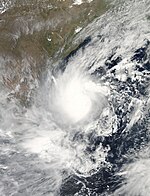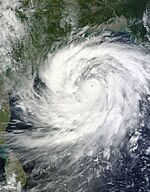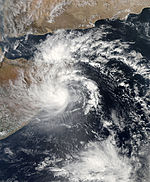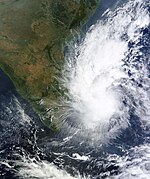2013 North Indian Ocean cyclone season: Difference between revisions
| Line 216: | Line 216: | ||
|type=cyclone |
|type=cyclone |
||
|time=0830 IST (0300 UTC), 25 November 2013 |
|time=0830 IST (0300 UTC), 25 November 2013 |
||
|location=12.0°N, 92.0°E<br/>{{convert|80|km|abbr=on}} WNW of [[Port Blair]] |
|location=12.0°N, 92.0°E<br/>{{convert|80|km|abbr=on}} WNW of [[Port Blair]]<br/>{{convert|1250|km|abbr=on}} ESE of [[Machilipatnam]]<br/>{{convert|1180|km|abbr=on}} ESE of [[Kakinada]]<br/>{{convert|1100|km|abbr=on}} SE of [[Kalingapatnam]] |
||
|3sustained=55 |
|3sustained=55 |
||
|1sustained=65 |
|1sustained=65 |
||
| Line 237: | Line 237: | ||
====Current Storm Information==== |
====Current Storm Information==== |
||
As of |
As of 0830 IST (0300 UTC), 25 November 2013, Severe Cyclonic Storm Lehar was located near [[latitude]] 12.0°N and [[longitude]] 92.0°E, about {{convert|80|km|abbr=on}} west-northwest of [[Port Blair]], {{convert|1250|km|abbr=on}} east-southeast of [[Machilipatnam]], {{convert|1180|km|abbr=on}} east-southeast of [[Kakinada]] and {{convert|1100|km|abbr=on}} southeast of [[Kalingapatnam]]]. The system is forecasted to intensify further into a Very Severe Cyclonic Storm in the next 24 hours, track west-northwestwards and cross Andhra Pradesh coast between Machilipatnam and Kalingapatnam near Kakinada around noon of 28 November. Maximum sustained 3-minute wind speeds are estimated at {{convert|100|km/h|abbr=on}}, gusting to {{convert|120|km/h|abbr=on}}. Minimum central pressure is estimated at {{convert|990|mbar|inHg|abbr=on}}. [[Dvorak technique|Dvorak intensity]] of the storm is T3.5. |
||
This system is expected to make landfall close to [[Kakinada]]. Kakinada is in the Coastal Andhra region which has already been hit twice by two cyclones, Phailin and Helen.<ref>{{cite web|title=After Helen, Andhra braces for super cyclone Lehar|url=http://timesofindia.indiatimes.com/india/After-Helen-Andhra-braces-for-super-cyclone-Lehar/articleshow/26315203.cms|publisher=The Times of India|accessdate=24 November 2013}}</ref> |
|||
For more latest official information on this storm, click through the links below: |
For more latest official information on this storm, click through the links below: |
||
Revision as of 07:58, 25 November 2013
| 2013 North Indian Ocean cyclone season | |
|---|---|
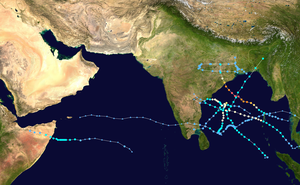 Season summary map | |
| Seasonal boundaries | |
| First system formed | May 10, 2013 |
| Last system dissipated | Currently active |
| Strongest storm | |
| Name | Phailin |
| • Maximum winds | 215 km/h (130 mph) (3-minute sustained) |
| • Lowest pressure | 940 hPa (mbar) |
| Seasonal statistics | |
| Depressions | 9 |
| Deep depressions | 5 |
| Cyclonic storms | 4 |
| Severe cyclonic storms | 2 |
| Very severe cyclonic storms | 1 |
| Total fatalities | At least 480 total |
| Total damage | At least $702.14 million (2013 USD) |
The 2013 North Indian Ocean cyclone season is an ongoing event in the annual cycle of tropical cyclone formation. The North Indian Ocean cyclone season has no official bounds, but cyclones tend to form between April and December, with the peak from May to November. These dates conventionally delimit the period of each year when most tropical cyclones form in the northern Indian Ocean.
The scope of this article is limited to the Indian Ocean in the Northern Hemisphere, east of the Horn of Africa and west of the Malay Peninsula. There are two main seas in the North Indian Ocean — the Arabian Sea to the west of the Indian subcontinent, abbreviated ARB by the India Meteorological Department (IMD); and the Bay of Bengal to the east, abbreviated BOB by the IMD.
The official Regional Specialized Meteorological Centre in this basin is the India Meteorological Department (IMD), while the Joint Typhoon Warning Center releases unofficial advisories. On average, 4 to 6 storms form in this basin every season.[1]
Season summary

Storms
Cyclonic Storm Mahasen
| Cyclonic storm (IMD) | |
| Tropical storm (SSHWS) | |
| Duration | May 10 – May 17 |
|---|---|
| Peak intensity | 85 km/h (50 mph) (3-min); 990 hPa (mbar) |
Originating from an area of low pressure over the southern Bay of Bengal in early May 2013, Mahasen slowly consolidated into a depression on May 10.[2] The depression gained forward momentum and attained gale-force winds on May 11 and was designated as Cyclonic Storm Mahasen, the first named storm of the season.[3] Owing to adverse atmospheric conditions, the depression struggled to maintain organized convection as it moved closer to eastern India.[4] On May 14, the exposed circulation of Mahasen turned northeastward.[5] The following day, conditions again allowed for the storm to intensify. Early on May 16, the cyclone attained its peak intensity with winds of 85 km/h (50 mph) and a barometric pressure of 990 mbar (hPa; 29.18 inHg).[6] Shortly thereafter Mahasen made landfall near Chittagong, Bangladesh.[7] On May 17, it moved over the eastern Indian state of Nagaland.[8]
Early in the storm's existence, it brought flooding rains to much of northwestern Indonesia, resulting in significant damage. At least four people died and six others were reported missing.[9][10] In preparation for the storm, large-scale evacuations were recommended for parts of Myanmar. This resulted with people overcrowding boats to escape, and one or several vessels capsized, causing at least 39 deaths; 42 people were rescued while 19 others were unaccounted for and feared dead.[11][12] The storm's expansive cloud mass also brought unsettled weather to Sri Lanka, Thailand, and southeastern India. Severe storms in India and Sri Lanka were responsible for at least 16 fatalities and significant damage;[13][14] one person died in Thailand.[15] Striking Bangladesh in a weaker state than initially expected, damage was moderate to severe. A total of 95,003 poorly constructed huts were damaged or destroyed, 17 people died, and nearly 1.3 million were affected across the country.[16][17] Losses to crops exceeded ৳400 million (US$5.14 million).[18] Myanmar was spared damage and further casualties.[19]
Depression BOB 02
| Depression (IMD) | |
| Duration | May 29 – May 31 |
|---|---|
| Peak intensity | 45 km/h (30 mph) (3-min); 990 hPa (mbar) |
An upper air cyclonic circulation developed into a low pressure area on 28 May. It slowly organized itself, and favorable conditions led to the intensification of the low pressure area to a depression by the early hours of 29 May.[20] Slightly intensifying thereafter, the storm took a northward track and crossed the West Bengal coast in the evening hours of the same day, with peak winds of 45 km/h (28 mph).[21] The depression attained its minimum central pressure of 990 mbar (29 inHg) on 30 May. Staying almost a day inland maintaining depression strength, it weakened gradually and dissipated over the states of Bihar and Jharkhand in the evening hours of 31 May due to land interaction and reduced moisture availability.[22] Contai in West Bengal recorded 260 mm rainfall in 24 hrs on 30 May 2013.[23]
Depression BOB 03
| Depression (IMD) | |
| Duration | July 30 – August 1 |
|---|---|
| Peak intensity | 45 km/h (30 mph) (3-min); 990 hPa (mbar) |
A low pressure area formed over the Bay of Bengal on July 29. It intensified gradually, and the IMD classified the storm as a Depression in the early hours of July 30. The system made landfall between Balasore, Odisha and Digha, West Bengal by the same evening at peak winds of 45 km/h (28 mph) and a minimum central pressure of 990 mbar (990 hPa). Spending an entire day inland, the depression weakened into a well-marked low pressure area on August 1 over the state of Madhya Pradesh in India.[24]
The storm's precursor brought heavy rainfall to coastal Bangladesh. 30,000 people were marooned as a result of the following severe floods in Kalapara Upazila.[25] In India, a Storm Warning Signal-3 was hoisted in the ports of Odisha, and fishermen were cautioned against venturing into the sea.[26] Chicholi in Madhya Pradesh recorded 280 mm rainfall in 24 hrs on 1 August 2013.[27]
Land Depression 01
| Depression (IMD) | |
| Duration | August 20 – August 23 |
|---|---|
| Peak intensity | 45 km/h (30 mph) (3-min); 990 hPa (mbar) |
A monsoonal low pressure area formed over the Bay of Bengal on August 16. It gradually intensified, organizing itself into a Depression in the early hours of August 20 over coastal West Bengal and adjoining northern Odisha and Jharkhand. Over the next few days, the storm moved west-northwestward, before weakening into a well-marked low pressure area on August 23.
The depression brought heavy rainfall to coastal West Bengal. Kolkata received 206 mm (8.1 in) of rainfall over a span of three days, the wettest spell of the monsoon season, causing inundated streets. At least four people are reported to be killed across the state due to rain-related events.[28] The system's precursor low caused authorities to raise cautionary signal number 3, at all maritime ports of Bangladesh.[29] Between August 21–23 (72 hrs),Pachmarhi in Madhya Pradesh recorded 500 mm rainfall from the Depression.[30]
Very Severe Cyclonic Storm Phailin
| Extremely severe cyclonic storm (IMD) | |
| Category 5 tropical cyclone (SSHWS) | |
| Duration | October 8 (Entered basin on Oct. 6) – October 14 |
|---|---|
| Peak intensity | 215 km/h (130 mph) (3-min); 940 hPa (mbar) |
A tropical depression formed along the Gulf of Thailand on October 4. The tropical depression degenerated to a remnant low on October 6, as it crossed the 100th meridian on October 7.[31] Under the influence of an upper air cyclonic circulation, it regenerated to a low pressure area over the Andaman Sea and adjoining Tanintharyi region. It slowly organized itself and consolidated into a depression on October 8, followed by the Joint Typhoon Warning Center (JTWC) issuing a Tropical Cyclone Formation Alert (TCFA) the same day.[32][33] In the early hours of 9 October the JTWC upgraded the storm to a tropical cyclone.[34] The same day, the IMD upgraded the storm to a deep depression, and subsequently a cyclonic storm, naming it Phailin. Rapid intensification ensued, and Phailin strengthened into a Very Severe Cyclonic storm on October 10, followed by the JTWC upgrading the storm to a strong Category 4 status. Continuing its rapid intensification, the storm reached Category 5 status the following day, the first in the North Indian Ocean since Cyclone Sidr in 2007.[35] Shortly before landfall, Phailin began another eyewall replacement cycle which led to slight weakening, and the system jumped back to Category 4 status.[36] Maintaining intensity, the storm made landfall close to Gopalpur, Odisha in the evening hours of October 12.[37] Phailin rapidly weakened as it tracked over rugged terrain, eventually dissipating into a well marked low pressure area over the state of Bihar on October 14.[38]
The cyclone prompted India's biggest evacuation in 23 years with more than 550,000 people moving up from the coastline in Odisha and Andhra Pradesh to safer places.[39] 44 deaths related to the cyclone have been reported.[40]
Deep Depression ARB 01
| Deep depression (IMD) | |
| Tropical storm (SSHWS) | |
| Duration | November 8 – November 11 |
|---|---|
| Peak intensity | 55 km/h (35 mph) (3-min); 1002 hPa (mbar) |
In early November, a low pressure area formed over the Arabian Sea. It slowly moved westwards and consolidated into Depression ARB 01 on November 8.[41] The JTWC issued a Tropical Cyclone Formation Alert the same day, reporting that the depression was moving into an area favorable for further intensification.[42] The next morning, the IMD upgraded the storm to a deep depression; the JTWC similarly upgraded the system to a tropical storm following reports of 65 km/h (40 mph) winds near the storm's center of circluation.[43][44] Remaining stationary for nearly a day, the storm crossed the coast of Somalia early on 11 November.[45] The system rapidly deteriorated due to land interaction, and both the JTWC and the IMD issued their final warnings on the system later that day.[46]
ARB 01 made landfall in the northeastern Puntland region on 9 November,[47] and dissipated by the 11th.[48] Around 300 fatalities were reported in the wake of the storm, as well as livestock casualties and demolished infrastructure. Much of the damage was averted by an early administrative response overseen by the Puntland Disaster Management and Rescue committee, which coordinated relief efforts by the Puntland Maritime Police Force, governmental rescue teams, and the Puntland Highway Authority.[49] According to the International Disaster Database (EM-DAT), the cyclone is tied with the Tropical Cyclone ARB04 of 1994 as Somalia's deadliest cyclone.[50]
Depression BOB 05
| Depression (IMD) | |
| Tropical storm (SSHWS) | |
| Duration | November 13 – November 16 |
|---|---|
| Peak intensity | 45 km/h (30 mph) (3-min); 1003 hPa (mbar) |
On November 8, the remnants of Tropical Depression 30W (Wilma) crossed the Malay Peninsula, and emerged into the eastern Bay of Bengal.[51] During the next several days, the system drifted towards the west while weakening further. On November 12, the system began to reorganize gradually, while continuing to move westwards. On November 13, the system was classified as a depression by the IMD, and given the identifier BOB 05.[52] The depression maintained its intensity despite passing through an environment unfavorable for intensification, and was re-upgraded to tropical cyclone intensity by the JTWC on 15 November.[53] Shortly before landfall, the system weakened due to land interaction, and the JTWC issued its final warning.[54] On November 16, BOB 05 made landfall near Nagapattinam, Tamil Nadu, and the system quickly began to weaken. Later on November 16, the IMD issued its final advisory on Depression BOB 05, as the system weakened into a well-marked area of low pressure.[55] Over the next several hours, the remnant low of BOB 05 moved across the central part of Southern India, and the system continued to weaken. During the next several days, BOB 05 moved westwards across the Arabian Sea as a convectionless low. Later, the remnants of BOB 05 redeveloped a little bit of convection, while continuing to moved westwards. Late on November 21, the remnants of BOB 05 turned to the southwest, affecting Socotra Island on November 22. Early on November 23, the remnants of Depression BOB 05 dissipated just south of Socotra Island.
Heavy rains along with 60-km wind speed lashed many parts of the state of Tamil Nadu. Mayiladuthurai, a town in Nagapattinam district, experienced the highest rainfall, amounting to 220 mm.[56] 13 people were killed as the Depression crossed the state's coast.[57]
Severe Cyclonic Storm Helen
| Severe cyclonic storm (IMD) | |
| Tropical storm (SSHWS) | |
| Duration | November 19 – November 23 |
|---|---|
| Peak intensity | 100 km/h (65 mph) (3-min); 990 hPa (mbar) |
Late on November 17, the remnant energy of Tropical Storm Podul contributed to the development of a trough over the Bay of Bengal, located near the Andaman Islands. During the next couple of days, the storm slowly organized and consolidated, prompting the Joint Typhoon Warning Center (JTWC) to issue a Tropical cyclone formation alert (TCFA) during the early hours of November 19.[58] Later on the same day, the India Meteorological Department (IMD) upgraded the storm to a depression, classifying it as BOB 06,[59] followed by the JTWC reporting that the storm had reached Tropical Storm strength.[60] A couple of hours later, the IMD upgraded BOB 06 into a Deep Depression, as the storm continued to intensify.[61]
The storm slowly drifted west-northwestward while deep convection consolidated around the system's well-defined center of circulation.[62] In the early hours of November 20, the IMD classified BOB 06 as a Cyclonic Storm, thereby officially naming it Helen.[63] Helen continued to intensify into a Severe Cyclonic Storm the following day, reaching its peak intensity of 100 km/h (62 mph) with a central pressure of 990 mbar (29 inHg). Shortly before landfall, the storm's convection sheared to the north, causing its low level circulation to fully expose followed by the JTWC issuing its final bulletin, reporting that the storm had weakened due to land interaction.[64] Helen made landfall south of Machilipatnam, Andhra Pradesh and rapidly deteriorated into a deep depression.[65][66] It was last noted as a low pressure area on November 23. A total of 11 deaths have been reported in incidents related to the cyclone.[67][68]
Cyclonic Storm Lehar
Template:Infobox indian current
A low pressure area formed over the South China Sea on 18 November. On November 23, it crossed to Andaman Sea and gradually intensified, and the JTWC classified the system as a tropical depression on November 23. Later on the same day, the storm was upgraded into Depression BOB 07 by the IMD, while the JTWC upgraded the system into a tropical storm.[69] The following day, the storm strengthened further into a cyclonic storm, and the IMD assigned it the name Lehar.[70]
Current Storm Information
As of 0830 IST (0300 UTC), 25 November 2013, Severe Cyclonic Storm Lehar was located near latitude 12.0°N and longitude 92.0°E, about 80 km (50 mi) west-northwest of Port Blair, 1,250 km (780 mi) east-southeast of Machilipatnam, 1,180 km (730 mi) east-southeast of Kakinada and 1,100 km (680 mi) southeast of Kalingapatnam]. The system is forecasted to intensify further into a Very Severe Cyclonic Storm in the next 24 hours, track west-northwestwards and cross Andhra Pradesh coast between Machilipatnam and Kalingapatnam near Kakinada around noon of 28 November. Maximum sustained 3-minute wind speeds are estimated at 100 km/h (62 mph), gusting to 120 km/h (75 mph). Minimum central pressure is estimated at 990 mbar (29 inHg). Dvorak intensity of the storm is T3.5.
For more latest official information on this storm, click through the links below:
- The IMD's latest Cyclone Warning
- The IMD's latest Cyclone Advisory
- The IMD's latest Forecast Track
- The JTWC's latest Cyclone Warning
- The JTWC's latest Forecast Track
Storm names
Within this basin, a tropical cyclone is assigned a name when it is judged to have reached Cyclonic Storm intensity with winds of 65 km/h (40 mph). The names were selected by members of the ESCAP/WMO panel on Tropical Cyclones between 2000 and May 2004, before the Regional Specialized Meteorological Center in New Delhi started to assign names in September 2004. There is no retirement of tropical cyclone names in this basin since the list of names is only scheduled to be used once before a new list of names is drawn up. Should a named tropical cyclone move into the basin, from the Western Pacific then it will retain its original name. The next six available names from the list of North Indian Ocean storm names are below.
|
|
Season effects
This is a table of all storms in the 2013 North Indian Ocean cyclone season. It mentions all of the season's storms and their names, durations, peak intensities (according to the IMD storm scale), landfall(s) – denoted by bold location names – damages, and death totals. Damage and death totals include the damage and deaths caused when that storm was a precursor wave or extratropical low, and all of the damage figures are in 2013 USD.
| Name | Dates | Peak intensity | Areas affected | Damage (USD) |
Deaths | Refs | ||
|---|---|---|---|---|---|---|---|---|
| Category | Wind speed | Pressure | ||||||
| Mahasen | May 10 – 17 | Cyclonic Storm | 85 km/h (50 mph) | 990 hPa (29.23 inHg) | Indonesia, Thailand, Sri Lanka, India, Bangladesh, Myanmar | >$5.14 million | 107 | |
| BOB 02 | May 29 – 31 | Depression | 45 km/h (30 mph) | 990 hPa (29.23 inHg) | Bangladesh, India | None | None | |
| BOB 03 | July 30 – August 1 | Depression | 45 km/h (30 mph) | 990 hPa (29.23 inHg) | Bangladesh, India | None | None | |
| LAND 01 | August 20 – 23 | Depression | 45 km/h (30 mph) | 990 hPa (29.23 inHg) | India | None | 4 | |
| Phailin | October 8 – 14 | Very Severe Cyclonic Storm | 215 km/h (130 mph) | 940 hPa (27.76 inHg) | Malay Peninsula, Andaman and Nicobar Islands, India | $696 million | 45 | |
| ARB 01 | November 8 – 11 | Deep Depression | 55 km/h (35 mph) | 1002 hPa (29.59 inHg) | Somalia, Ethiopia | $1 million | >300 | [71] |
| BOB 05 | November 13 – 16 | Depression | 45 km/h (30 mph) | 1003 hPa (29.62 inHg) | Malay Peninsula, Myanmar, Southern India, Sri Lanka, Socotra Island | None | 13 | |
| Helen | November 19 – 23 | Severe Cyclonic Storm | 100 km/h (65 mph) | 990 hPa (29.23 inHg) | India | None | 11 | |
| Lehar | November 23 – Currently active | Cyclonic storm | 75 km/h (45 mph) | 996 hPa (29.41 inHg) | Malay Peninsula, Andaman and Nicobar Islands | None | None | |
| Season aggregates | ||||||||
| 9 systems | May 10 – Currently active | 215 km/h (130 mph) | 940 hPa (27.76 inHg) | >702.14 million | >480 | |||
See also
- 2013 Atlantic hurricane season
- 2013 Pacific hurricane season
- 2013 Pacific typhoon season
- South-West Indian Ocean cyclone seasons: 2012–13, 2013–14
- Australian region cyclone seasons: 2012–13, 2013–14
- South Pacific cyclone seasons: 2012–13, 2013–14
References
- ^ "IMD Cyclone Warning Services: Tropical Cyclones".
- ^ India Meteorological Department (May 10, 2013). "Tropical Weather Out For North Indian Ocean Issued At 1200 UTC Of 10 May, 2013". India Meteorological Department. Retrieved 10 May 2013.
- ^ India Meteorological Department (May 11, 2013). "Cyclone Mahasen over southeastern Bay of Bengal, CWIND Bulletin 5". India Meteorological Department. Retrieved May 11, 2013.
- ^ Joint Typhoon Warning Center (May 12, 2013). "Tropical Cyclone 01B (Mahasen) Warning Nr 008". United States Navy. Retrieved May 12, 2013.
- ^ Joint Typhoon Warning Center (May 14, 2013). "Tropical Cyclone 01B (Mahasen) Warning Nr 017". United States Navy. Archived from the original on 2013-05-14. Retrieved May 14, 2013.
- ^ "Tropical Storm 'Mahasen' Advisory No. 41" (PDF). India Meteorological Department. May 16, 2013. Retrieved May 16, 2013.
- ^ "Tropical Storm 'Mahasen' Adviosry No. 43" (PDF). India Meteorological Department. May 16, 2013. Retrieved May 16, 2013.
- ^ "Depression over Manipur weakened" (PDF). India Meteorological Department. May 17, 2013. Retrieved May 17, 2013.
- ^ "Thousands homeless from floods in Indonesia's Aceh district". Jakarta, Indonesia: United Press International. May 11, 2013. Retrieved May 16, 2013.
- ^ Aris Cahyadi (May 13, 2013). "Aceh Landslide Kills 3 Bus Passengers". Jakarta Globe. Retrieved May 16, 2013.
- ^ Associated Press (May 14, 2013). "Cyclone Mahasen: Boats Carrying Fleeing Rohingya Muslims Capsize Off Coast Of Myanmar". Sittwe, Myanmar: The Huffington Post. Retrieved May 14, 2013.
- ^ Gaurav Raghuvanshi and Syed Zain Al-Mahmood (May 16, 2013). "Cyclone Mahasen Weakens as It Hits Bangladesh". Wall Street Journal. Retrieved May 16, 2013.
- ^ Press Trust of India (May 14, 2013). "Cyclone 'Mahasen' hits Sri Lanka, seven killed". Times of India. Colombo, Sri Lanka. Retrieved May 14, 2013.
- ^ Press Trust of India (May 13, 2013). "Eight killed, four injured in Andhra Pradesh cyclonic storm". Hyderabad, India: New Delhi Television Limited. Retrieved May 14, 2013.
- ^ "Turbulent seas at west coast; 1 person killed during storm's passing". Nakhon Sawan, Thailand: National News Bureau of Thailand. May 14, 2013. Retrieved May 14, 2013.
- ^ "Disaster relief emergency fund (DREF) Bangladesh: Tropical Cyclone Mahasen" (PDF). International Federation of Red Cross and Red Crescent Societies. ReliefWeb. May 18, 2013. Retrieved May 18, 2013.
- ^ Deutsche Presse-Agentur (May 17, 2013). "Bangladesh assesses cyclone damage as toll climbs to 17". The Hindu. Retrieved May 17, 2013.
{{cite web}}: Italic or bold markup not allowed in:|publisher=(help) - ^ "Mahasen aftermath: Thousands under the open sky". Dhaka Tribune. May 18, 2013. Retrieved May 18, 2013.
{{cite web}}: Italic or bold markup not allowed in:|publisher=(help) - ^ Paul Vrieze and Htet Naing Zaw (May 16, 2013). "Cyclone Mahasen Misses Burma, Bringing Relief to Displaced Rohingyas". Sittwe, Myanmar: The Irrawaddy. Retrieved May 16, 2013.
{{cite web}}: Italic or bold markup not allowed in:|publisher=(help) - ^ India Meteorological Department. "Depression BOB 02 Bulletin 01". India Meteorological Department. Retrieved 2 June 2013.
- ^ India Meteorological Department. "Special Tropical Weather Outlook issued at 1600 UTC, 29 May 2013". India Meteorological Department. Retrieved 2 June 2013.
- ^ India Meteorological Department. "Depression BOB 02 Bulletin 13". India Meteorological Department. Retrieved 2 June 2013.
- ^ http://www.imd.gov.in/section/nhac/dynamic/Cyclone_29_31_05_2013.pdf
- ^ India Meteorological Department. "IMD Cyclone Warning Bulletin 9 Issued at 1130 IST, August 1, 2013". India Meteorological Department. Retrieved 1 August 2013.
- ^ Swapan, Anisur Rahman (28 July 2013). "30,000 people marooned in coastal Kalapara". Dhaka Tribune. Retrieved 2 August 2013.
- ^ IANS (30 July 2013). "Depression over Bay of Bengal, Odisha fishermen alerted". The Times of India. Retrieved 2 August 2013.
- ^ http://www.imd.gov.in/section/nhac/dynamic/Depression30thJuly-1stAugust.pdf
- ^ Telegraph India. "As if the downpour weren't enough, there's strong tide stirring too". Telegraph India. Retrieved 21 August 2013.
- ^ bdnews24.com. "MET warning on Bay of Bengal low". bdnews24.com. Retrieved 21 August 2013.
{{cite web}}: CS1 maint: numeric names: authors list (link) - ^ http://www.imd.gov.in/section/nhac/dynamic/Depression.pdf
- ^ "Possible Cyclone Phailin, Typhoon Nari, and Its snowing!". robspeta. Retrieved October 6, 2013.
- ^ "IMD Bulletin BOB 04/2013/01". India Meteorological Department. Retrieved 8 October 2013.
- ^ Joint Typhoon Warning Center. "Tropical Cyclone Formation Alert WTIO21 Issued at 08/1000Z". Joint Typhoon Warning Center. Retrieved 8 October 2013.
- ^ Joint Typhoon Warning Center. "Tropical Cyclone 02B (Two) Warning #01 Issued at 09 October 2013 - 0300 UTC". Joint Typhoon Warning Center. Retrieved 9 October 2013.
- ^ Joint Typhoon Warning Center. "Tropical Cyclone 02B (Phailin) Warning #11". Joint Typhoon Warning Center. Retrieved 11 October 2013.
- ^ Joint Typhoon Warning Center (October 12, 2013). "Tropical Cyclone 02B (Phailin) Warning 14 October 12, 2013 03z". United States Navy, United States Air Force. Archived from the original on October 12, 2013. Retrieved October 12, 2013.
- ^ India Meteorological Department. "IMD Cyclone Warning for Indian coast - Bulletin 35 issued for Cyclone Phailin at 0130 IST, 13 October 2013 (2000 UTC, 12 October 2013)". India Meteorological Department. Retrieved 15 October 2013.
- ^ India Meteorological Department. "IMD Cyclone Warning for Indian coast, issued at 1630 IST (1100 UTC), 14 October 2013". India Meteorological Department. Retrieved 15 October 2013.
- ^ "Cyclone Phailin triggers India's biggest evacuation operation in 23 years". NDTV. 12 October 2013. Retrieved 13 October 2013.
- ^ http://www.thehindu.com/news/national/other-states/odisha-focuses-on-relief-as-phailin-toll-rises-to-44/article5247992.ece
- ^ India Meteorological Department. "IMD Special Tropical Weather Outlook — November 8, 2013". Retrieved 8 November 2013.
- ^ Joint Typhoon Warning Center. "Tropical Cyclone Formation Alert WTIO21 Issued at 08 November 2013/1200Z". Joint Typhoon Warning Center.
- ^ India Meteorological Department. "IMD Special Tropical Weather Outlook - 0300 UTC, November 9, 2013". Retrieved 9 November 2013.
- ^ "Tropical Cyclone Warning 03 - Tropical Cyclone 03A". Joint Typhoon Warning Center. Retrieved 9 November 2013.
- ^ India Meteorological Department. "IMD Special Tropical Weather Outlook - 0300 UTC, 11 November 2013". India Meteorological Department. Retrieved 11 November 2013.
- ^ Joint Typhoon Warning Center. "Tropical Cyclone 03A (Three) Warning #10 (Final Warning) Issued at 11 November 2013/0300 UTC". Joint Typhoon Warning Center.
- ^ "Officials: Up to 100 Killed in Somalia Cyclone". VOA. 11 November 2013. Retrieved 23 November 2013.
- ^ "Deadly tropical cyclone hit Somalia on November 10-11". EarthSky. 12 November 2013. Retrieved 23 November 2013.
- ^ "Somalia: 360 reportedly dead in Puntland cyclone amid rescue operations". Garowe Online. 13 November 2013. Retrieved 23 November 2013.
- ^ "Haiyan Finally Dying; Somalia's Deadliest Tropical Storm on Record Kills 100". Wunderground. November 11, 2013. Retrieved November 22, 2013.
- ^ Joint Typhoon Warning Center (8 Nov 2013). "Significant Tropical Weather Advisory for the Indian Ocean". Retrieved 13 Nov 2013.
- ^ India Meteorological Department. "IMD CWIND Bulletin 01 for Depression BOB 05 - Issued at 0900 IST (0330 UTC), 13 November 2013". India Meteorological Department. Retrieved 13 November 2013.
- ^ Joint Typhoon Warning Center (JTWC). "Tropical Cyclone 30W (Thirty) Warning #14 Issued at 15 November 2013, 1500 UTC". Joint Typhoon Warning Center (JTWC). Retrieved 15 November 2013.
- ^ Joint Typhoon Warning Center (JTWC). "Tropical Cyclone 30W (Thirty) Warning #17 Issued at 16 November 2013, 0900 UTC". Joint Typhoon Warning Center (JTWC). Retrieved 16 November 2013.
- ^ http://www.imd.gov.in/section/nhac/dynamic/rsmc.pdf
- ^ http://www.thehindu.com/todays-paper/tp-national/tp-tamilnadu/inspections-begin-in-mayiladuthurai-sirkazhi/article5362765.ece
- ^ http://www.deccanherald.com/content/369565/13-killed-rain-depression-crosses.html
- ^ Joint Typhoon Warning Center. "Tropical Cyclone Formation Alert Issued at 19 November 2013, 0200 UTC". Joint Typhoon Warning Center. Retrieved 19 November 2013.
- ^ India Meteorological Department. "IMD Bulletin 1 for BOB 06 issued on 19 November 2013, 0300 UTC". India Meteorological Department. Retrieved 19 November 2013.
- ^ Joint Typhoon Warning Center. "Tropical Cyclone 04B (Four) Warning #01 Issued at 19 November 2013,1500 UTC". Joint Typhoon Warning Center. Retrieved 19 November 2013.
- ^ "IMD Cyclone Warning BOB06/2013/05 for India". India Meteorological Department. Retrieved 20 November 2013.
- ^ "Tropical Cyclone 04B Warning 3, issued at 0300 UTC, 20 November 2013". Joint Typhoon Warning Center. Retrieved 20 November 2013.
- ^ "Cyclone Warning BOB06/2013/08 for India". India Meteorological Department. Retrieved 20 November 2013.
- ^ Joint Typhoon Warning Center (JTWC). "Tropical Cyclone 04B (Helen) Warning #12 Final Warning Issued at 0900 UTC, 22 November 2013". Joint Typhoon Warning Center (JTWC). Retrieved 22 November 2013.
- ^ India Meteorological Department. "Severe Cyclonic Storm Helen Warning Bulletin 26 for the Indian coast, issued at 1630 IST (1100 UTC), 22 November 2013". India Meteorological Department. Retrieved 22 November 2013.
- ^ India Meteorological Department. "Severe Cyclonic Storm Helen Warning Bulletin 27 for the Indian coast, issued at 1900 IST (1330 UTC), 22 November 2013". India Meteorological Department.
- ^ http://cinemamirchi.com/wp/cyclone-helen-brings-heavy-rains-11-feared-dead/
- ^ http://news.fullhyderabad.com/hyderabad-news/cyclone-helen-causes-devastation-in-5-districts-in-ap-10709.html
- ^ Joint Typhoon Warning Center. "Tropical Cyclone 05B (Five) Warning #01 Issued on 23 November 2013, 0900 UTC". Joint Typhoon Warning Center. Retrieved 23 November 2013.
- ^ "IMD Cyclone Warning BOB07/2013/02 for India". India Meteorological Department. Retrieved 24 November 2013.
- ^ "Somalia cyclone: 140 confirmed dead in Puntland". BBC News. 13 November 2013. Retrieved 13 November 2013.

